Reading the Song Charts
Santa's ListUnder Santa's instruction, we give you enough information to help you navigate through each Christmas song with a minimum of fuss! Below is a list of topics that will give you a better understanding of reading the song charts on this site, including examples where necessary... Santa will be pleased.
Arrangement Details:
At the start of every song we include
- Song Key: Major or Minor
- Key Signature: How many sharps or flats there are in the song key.
- Time Signature: Placed at the start of every song chart (e.g., 4/4).
- Tempo: expressed as bpm (beats per minute)
- Vocal Range: e.g., C4 - D6 (C4 is Middle C on a keyboard)
- Guitar Tuning: e.g., E A D G B e (standard tuning)
- Skill Level: Beginner / Intermediate / Advanced
- Chords: All chords relating to the song
Lyrics & Chord Placement:
Words with more than one syllable are separated with a dash. We do this as some chord changes may occur on the 2nd or 3rd syllable of a word. The chords are placed directly above the first letter of each word or syllable. Here are some examples:
A D In my own way... G D G I will com-fort you... C G You need to con-si-der...
There are other times where chords are played before or after a word. The chords are placed accordingly. Here are some examples:
E7 Am Can't you see I'm no good with-out you... C E7 Am Geor-gia, Geor-gia...
Chord Charts:
Chord Charts are included on every song sheet. We include charts for Right & Left Handed Guitarists. Here are some examples:
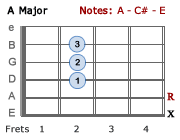
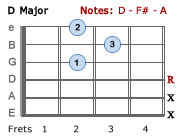
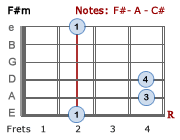
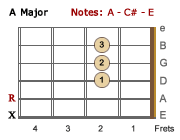
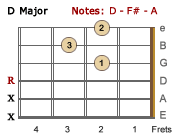
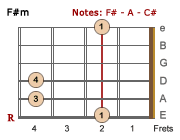
Time Signatures:
Time signatures are place at the beginning of every song, e.g., Intro: 4/4
This sets the timing of each song - the number of beats per bar and the value of each beat. The most common time signatures are 4/4 followed by 3/4, 2/4, 2/2, 6/8 etc.
- 4/4: 4 beats per bar with each beat having the value of a quarter note
| 𝅘𝅥 𝅘𝅥 𝅘𝅥 𝅘𝅥 | 𝅘𝅥 𝅘𝅥 𝅘𝅥 𝅘𝅥 | - 3/4: 3 beats per bar with each beat having the value of a quarter note
| 𝅘𝅥 𝅘𝅥 𝅘𝅥 | 𝅘𝅥 𝅘𝅥 𝅘𝅥 | - 2/4: 2 beats per bar with each beat having the value of a quarter note
| 𝅘𝅥 𝅘𝅥 | 𝅘𝅥 𝅘𝅥 | - 2/2: 2 beats per bar with each beat having the value of a half note
| 𝅗𝅥 𝅗𝅥 | 𝅗𝅥 𝅗𝅥 | - 6/8: 6 beats per bar with each beat having the value of an eighth note
| 𝅘𝅥𝅮 𝅘𝅥𝅮 𝅘𝅥𝅮 𝅘𝅥𝅮 𝅘𝅥𝅮 𝅘𝅥𝅮 | 𝅘𝅥𝅮 𝅘𝅥𝅮 𝅘𝅥𝅮 𝅘𝅥𝅮 𝅘𝅥𝅮 𝅘𝅥𝅮 |
Sometimes you will come across changes in the time signature. This seldom occurs, but when it does, the new time signature is placed wherever it occurs, e.g.,
Intro: 4/4...
G
O-ver and o-ver a-gain
Em Em B7 B7
What do I do?| | | (2/4) |
Em
(4/4)I am a...
Help with Timing:
Where timing is a little difficult in relation to chord changes, we add some timing counts, e.g., | 1 2 3 | or | 1& 2& 3& 4& | etc.
Consider the following examples:
Example 1: This Intro is in 3/4 time: 3 quarter-note beats per bar.
Dsus2 Dsus2/B Em/G A Asus A7sus/addE
Intro: 3/4 ‖: 1 2 3 | 1 2 3 | 1 2 3 | 1 2 3 :‖
The first 3 bars are pretty straightforward with each chord playing a full bar count, but on the fourth bar - each chord change happens on each beat of the bar.
Example 2: This Intro is in 4/4 time: 4 quarter-note beats per bar.
G D7 G D7 G G Em Bm D7 G
Intro: 4/4 |1& 2& 3&4& | 1&2& 3& 4& | 1& 2& 3& 4& | 1&2& 3&4& |
I have split each beat into 1& 2& 3& 4& etc. which is helpful in cases like this where timing is a little tricky.
In the first bar, chord changes occur on each of the first 2 beats but the G chord is played over the 3rd and 4th beats and continues to be played for the first 2 beats of the following bar.
Key Changes:
Sometimes when playing a song, you may come across a key change or two or three! This is also placed wherever it occurs, e.g.,
(key change...)
G G G G E E E E
|Joy Joy|Joy Joy|Joy Joy| Joy |Joy Joy|Joy Joy|Joy Joy| Joy |
Common Music Symbols:
Wherever possible, I have used music symbols as they help you to understand the song charts a little better. If you're familiar with music theory, you will find these symbols useful.
Note Symbols:
𝅝
Whole note / Semibreve
𝅗𝅥
Half Note / Minim
𝅘𝅥
Quarter Note / Crotchet
𝅘𝅥𝅮
Eighth Note / Quaver
𝅘𝅥𝅯
Sixteenth Note / Semi-Quaver
Bars:
| Single Bar line - divides music into equal sections
||
Double Bar line - indicates a specific section
Repeat Signs:
𝄆 𝄇 All bars between the double dotted bars are to be repeated
% Repeat previous bar e.g., | G | % | Play 2 bars of G Major
/ Repeat previous chord in a bar e.g., 4⁄4 | G / D / | Play G for 2 beats and D for 2 beats
Rests: Usually occurring in song Intros where you don't come in on the first beat of the bar - it may be an eighth-note rest (𝄾) or quarter note rest (𝄽) etc. Here are some examples:
Example 1:
G
Intro: 4/4 |𝄾 & 2& 3& 4& |
The G chord comes in half a beat after the start of the song. Because the song is in 4/4 time and we have an eighth-note rest, it is easier to split the timing into 8 parts, i.e., | 1& 2& 3& 4& | where each part equals half a beat.
Example 2: G
Intro: 4/4 | 𝄽 𝄽 𝄽 4 |
The G chord comes in on the 4th beat of the first bar after 3 quarter-note rests.
Fermata Symbol:
The Fermata symbol is placed above or below a chord to indicate a hold or pause.𝄐 Fermata Above
𝄑 Fermata Below
Added Bars:
These are usually inserted at the end of a line or verse / chorus / bridge, where more than 1 bar is played. These are usually added to give you a better representation of the song, especially if you are not familiar with it.
Bb C
Bridge: The blind will see The deaf will hear
Dm C Bb
The dead will live a-gain...
Gm C
The lame will leap The dumb will speak
Dm Dm A
The prais-es of The | Lamb...| | 𝄎 |
The Transposer:
Very handy for implementing chord transpositions, however due to the nature of the app, there are some situations where you may find it confusing.
The Transposer doesn't enable bars on the same line as chords - the bars and hyphens are placed directly below the chords, e.g.,E E7 | - |
In this example in 4⁄4 time, the hyphen represents an even split in the timing count of the bar, 2 beats on E and 2 beats on E7.
This could also be written as:E E7 | / / |
More Examples:
Fmaj7 is played for 6 beats and G is played for 2 beats.
Fmaj7 G
4⁄4 | | / / |
Am is played for 4 beats, C for 3 beats and G for 1 beat.
Am C G
4⁄4 | | / / / / |
Chords with leading Bass Notes:
When you see chords like D/F#, G/D etc., the first chord is stated and leads with a bass note indicated after the forward slash, therefore G/D is a G chord leading with a D bass note.
In these situations, the Transposer doesn't take into account the space taken up by the bass note after the forward slash. If there are any chords on the same line after these bass notes, they are pushed forward the same amount of space taken up by the bass note .
This means that the proceeding chords don't line up as they should as they are generally placed directly above the lyrics where chord changes occur. So just be aware that when you see these types of chords, the chord line-up may be slightly altered.